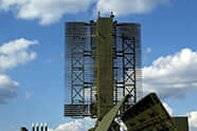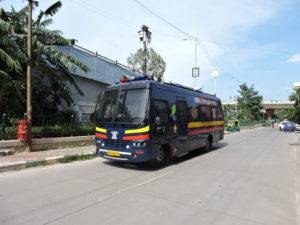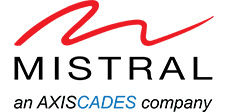Introduction
In the event of a terror strike – a plane hijack or an assault on critical infrastructure – special operations forces are usually called in to counter and break the strike, should negotiations fail to achieve a peaceful resolution of the problem.
Special Ops. forces require detailed information about the target location and operating conditions at the location, prior to an operation, and this information is typically provided by sensors carried by specialized delivery platforms. Depending on the stand-off distance and the level of covertness, the choices available to the forces vary.
An October 2010 Tech. Brief – Surveillance-Sensor Delivery Platforms – talked in general about various specialized sensor-delivery platforms. This brief will discuss two specialized sensor-delivery platforms useful to Special Ops. forces in executing tactical operations (as distinct from planning tactical operations).
EyeBallTM R1
EyeBallTM R1 (EyeBall) is an advanced, audio/visual surveillance sensor that can be deployed and operated by a single person. Each unit is slightly larger than a cricket ball (about 20% larger), making deployment easy; simply throw the EyeBall into the target area, or mount it on a pole, or lower it on a cable through a tunnel. EyeBall is self-righting and rotates, to provide continuous 360° video and audio coverage of the target area. Night illumination, visible or invisible, allows the EyeBall to operate at night or in low-light/no-light areas. Moreover, the sensor is rugged enough to survive a “throw” or “roll” of more than 50 meters with landings in rough terrain, concrete, piles of debris, or through windows.
The functional capabilities of the device is summaried below:
- Compact and lightweight for easy transport
- 360° audio visual coverage
- Transmission range of 150 meters outdoors and 35 meters indoors
- Continuous operation for up to 2½ hours
- Night vision capability
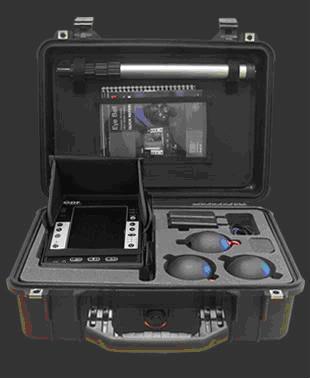
Figure 1: EyeBall Kit
Credit: ODF Optronics Ltd. www.odfopt.com
An Eyeball Kit consists of the following items:
2 Eye BallTM R1 sensors
- 470 TVL (slightly lower than 640 * 480 resolution) camera
- 25 fps live video
- Omnidirectional microphone with the capability to detect human voice from a distance of 5 metres
- 8 metre NIR (Near IR) illumination, for low-light/no-light camera operation
- Wireless transmission sub-system – approximately 35 metres indoors and 150 metres outdoors
- 4 rpm rotation motor, for 360° audio visual coverage
- Rechargeable battery pack with up to 2½ hours of charge time (illumination off) or 2 hours of charge time (illumination on)
- 580 grammes, quick self-stabilisation industrial design
Portable Display & Control Unit (PDU)
- Enables display of 2 sensors alternatively
- 960 (V) * 234 (H) resolution
- 6.4” LCD screen
- Continuous operation up to 3 hours
- S-video connector and earphone jack
2 Chargers 8.4V 3-pin
- Chargers for the EyeBall sensors and the PDU
- 110 – 220 V AC
Training Ball
- Practice unit
Telescopic Monopod Pole
- Raises an Eyeball sensor, while keeping the operator safe
Lowering wire adaptor
- Lowers an Eyeball sensor, while keeping the operator safe
1/4″ to 1/8″ Adaptor
- Necessary if Eyeball sensor is to be connected any standard 3rd-party attachment equipment
4 Sensor Retrieval Clip Rings
- Used to attach a retrieval mechanism, for an EyeBall sensor thrown into a hazardous area
2 Pull Pins
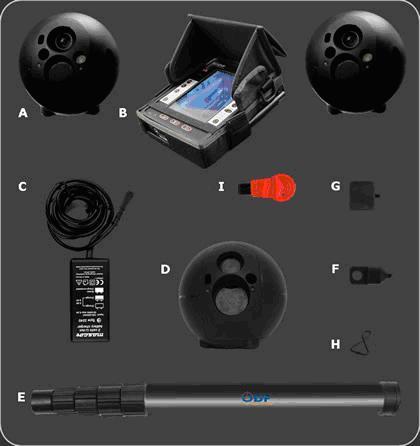
Figure 2: Components of an EyeBall Kit
Credit: ODF Optronics Ltd. www.odfopt.com
In addition to observing the video stream on the PDU, the streams can also be viewed on an observation PC by the operations commander. For this purpose, an Observation Kit is optionally available, to connect to an on-field notebook.
EyeDrive
EyeDriveTM is an observation and surveillance remote-controlled, lightweight mini-robot that provides continuous real-time 360° audio and video surveillance. With EyeDrive’s proprietary Point ‘n Go™ navigation feature, deploying these rugged surveillance robots is intuitive and easy. In addition, there is space on the device to carry additional sensor payloads, depending on the specific requirements of the user.
The operator can remain in safe conditions when deploying and placing the remote-controlled robot. It searches corridors and rooms prior to entry, searches under vehicles, and observes and detects suspicious objects. The robot can be placed in standby mode and activated when required. The unique Point ‘n Go navigation directs the robot to any location, merely by having the operator touch the location on the panoramic view on the control unit. Since no joystick is required, the operator is able to focus on the mission, rather than on manoeuvering the robot.
The robot is equipped with a robust proprietary Video Motion Detection (VMD) providing early automatic alerts of significant events based on video and audio detection. Events can be recorded, logged and retrieved for evidence and debriefing and/or sent to remote command centers.
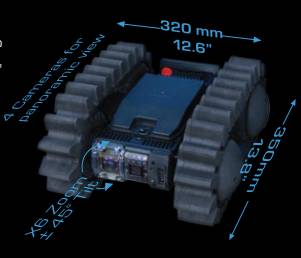
Figure 3: EyeDrive
Credit: ODF Optronics Ltd. www.odfopt.com
The highlights of the system are as follows:
- Clear, precise, real-time 360° video images and sound
- 4 cameras for all around view + 5th Tilt and Zoom camera
- Robust ODF proprietary Video Motion Detection (VMD) providing early automatic alerts of significant events based on video and audio detection
- Recording of the events (video and audio) for evidence and debriefing with user-friendly logging and retrieval capabilities
- Compact, lightweight rugged and easy-to-use: can be tossed over walls or through windows
- Usable day, night, and in all weather conditions
- Point ‘n Go navigation for intuitive operation & control
- Lightweight – Robot weighs only 3.5 kgs
- Carries up to 3 kgs of deployable sensors

Figure 4: 360° video from EyeDrive
Credit: ODF Optronics Ltd. www.odfopt.com
Each EyeDrive system includes the following:
- A choice of one or two mini-robots
- Communication Unit
- Laptop (supplied by the vendor or customer)
- Charger and additional robot battery
- Tactical operations vest, to carry the unit during an operation (optional)
Conclusion
With the availability of variety of sensorial aid to special ops. forces, the potential information that can be gathered prior to or during an operation has increased manifold. As the saying goes, forewarned is forearmed; so, it pays to have prior warning of what one is getting into, when launching an operation. The two products, described above, are very good examples of sensor-delivery platforms tailored for the requirements of special ops. forces.
Mistral offers a variety of sensors and sensor-delivery platforms in the Indian market, targeted at the specific requirements of homeland security agencies.

